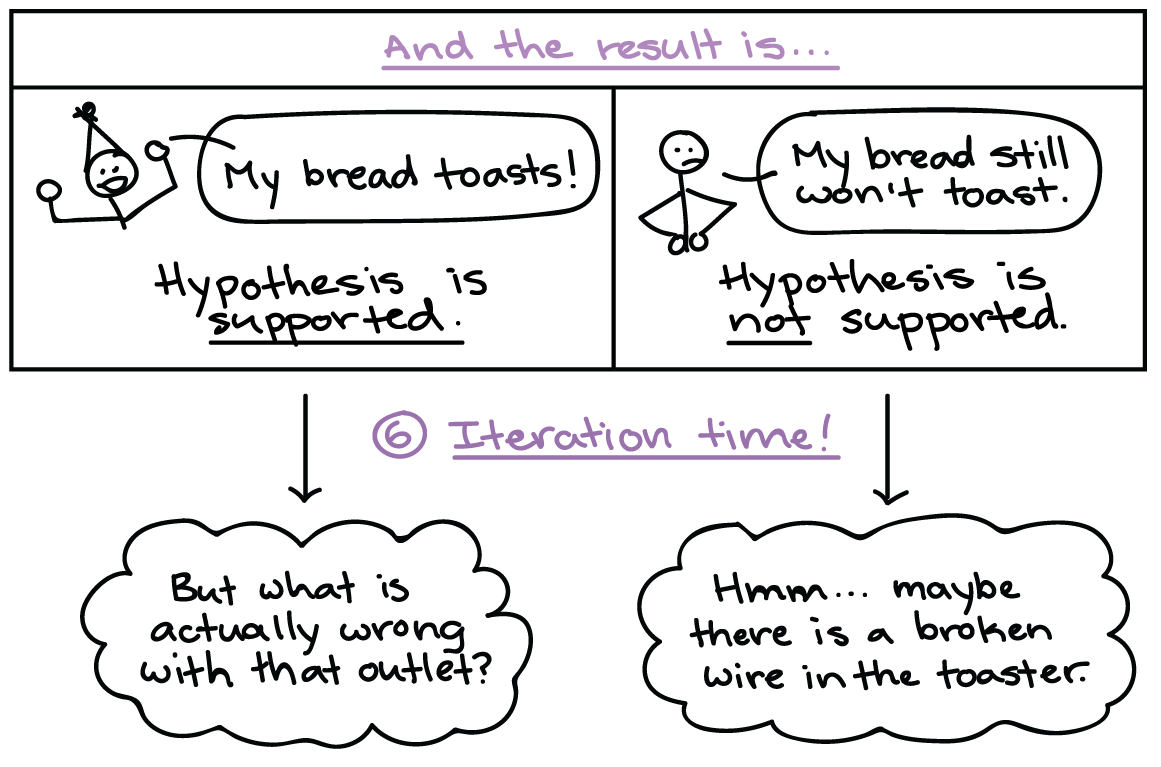To begin with, What is this Intriguing method? The Scientific Method is a series of procedures that individuals can utilize to know more about the world around them, better that knowledge, and set out to to elucidate why and/or how things come about.
1. Make an Observation
Suppose that you get two slices of bread and put them into the toaster. However, your bread does not toast.

2. Ask a question
Oh no!!! Why won't the bread toast?

3. Propose an Hypothesis
An hypothesis is a potential answer to the question, one that can be tested through an experiment.
4. Make a Prediction
A Prediction is an outcome we'd expect to see if the hypothesis is correct.
6. Iterate
The last step of the scientific method is to reflect on our results and use them to guide our next steps.

This method, or as they say Modus Operandi in Latin , involves recognizing observations, devising inquiries, forming hypotheses, performing experiments, analyzing the given facts and drawing a deduction. Every scientific experiment performed exemplifies the scientific method in action, but it is also used by non-science figures in everyday situations.
A Biology investigation usually starts with an observation—that is, something that catches the biologist’s attention.
For instance, a cancer biologist might notice that a specific kind of cancer can't be treated with chemotherapy and begin to wonder what the reason behind this abnormal result the case is. A marine ecologist, seeing that the coral reefs of her/his field sites are turning white otherwise known as bleaching, might set out to explore the reasons for this change.
How do scientists follow up on these observations? and How can you follow up on your own Observations of the Natural World?
In this blog, I, your dearest author Malak, will be walking you through the various steps of the, a logical problem-solving approach used by biologists and many other scientists, the fields in which its used in and providing you with general information about it.
The Scientific Method
How do scientists follow up on these observations? and How can you follow up on your own Observations of the Natural World?
In this blog, I, your dearest author Malak, will be walking you through the various steps of the, a logical problem-solving approach used by biologists and many other scientists, the fields in which its used in and providing you with general information about it.
The Scientific Method
At the core of biology and other sciences lies a problem-solving approach called the scientific method.
The scientific method has 5 basic steps, plus 1 feedback step:
- Recognize an observation.
- Inquire/Ask a question.
- Form a hypothesis, or testable explanation.
- Deduct a conclusion based on the hypothesis.
- Test/Validate the conclusion.
- Iterate: use the results to deduce a new hypothesis or prediction.
The scientific method is used in all sciences—including Chemistry, Physics, Geology and Psychology. The scientists in these fields ask different questions and perform different tests. However, they use the same core approach to find answers that are logical and supported by evidence.
1. Make an Observation
Suppose that you get two slices of bread and put them into the toaster. However, your bread does not toast.

2. Ask a question
Oh no!!! Why won't the bread toast?

3. Propose an Hypothesis
An hypothesis is a potential answer to the question, one that can be tested through an experiment.
For example, our hypothesis in this case could be that the toast didn't toast because the electrical outlet is broken.


This hypothesis is not necessarily the right explanation. Instead, it's a possible explanation that we can test to see if it is likely correct, or if we need to make a new hypothesis.
4. Make a Prediction
A Prediction is an outcome we'd expect to see if the hypothesis is correct.
In this case, we might predict that if the electrical outlet is broken, then plugging the toaster into a different outlet should remedy the problem.


5. Test the Predictions.
To test the hypothesis, we need to make an observation or perform an experiment associated with the prediction.
To test the hypothesis, we need to make an observation or perform an experiment associated with the prediction.
For instance, in this case, we would plug the toaster into a different outlet and see if it toasts.


- If the toaster does toast, then the hypothesis is supported—likely correct.
- If the toaster doesn't toast, then the hypothesis is not supported—likely wrong.
6. Iterate
The last step of the scientific method is to reflect on our results and use them to guide our next steps.

If the hypothesis was supported, we might do additional tests to confirm it or revise it to be more specific i.e we might have to investigate why the outlet is broken.
If the hypothesis was not supported, we would come up with a new hypothesis e.g the next hypothesis might be that there's a broken wire in the toaster.
In most cases, the scientific method is an iterative process (a cycle rather than a straight line). The result of one go-round becomes feedback that improves the next round of question asking.
What Subjects use the scientific method?
These activities do not describe all that scientists do but apply mostly to experimental sciences (e.g. physics, chemistry, biology and psychology). The elements above are often taught in the educational system as "The scientific method".

Comments
Post a Comment
We will love to hear from you...
Share your thoughts with us!